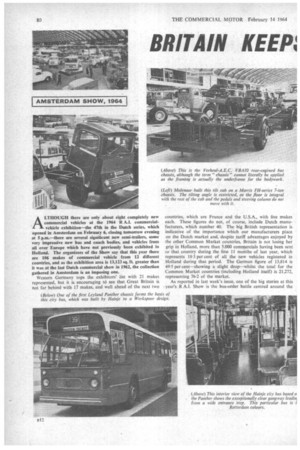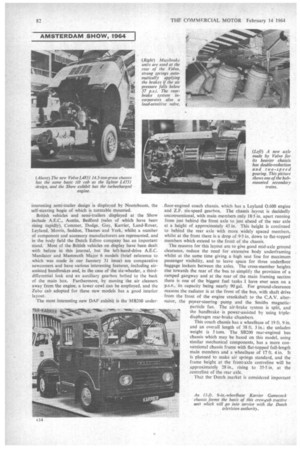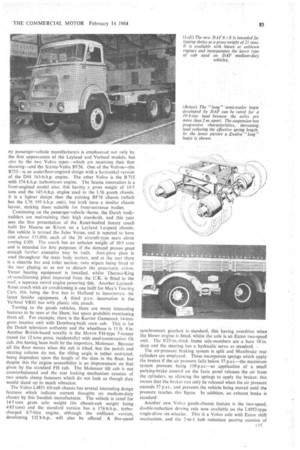BRITAIN KEEP; RIP ON DUTCH MARKET
Page 82

Page 83

Page 84

Page 85

Page 86

If you've noticed an error in this article please click here to report it so we can fix it.
By John F. Moon, A.M.I.R.T.E.
ALTHOUGH there are only about eight completely new commercial vehicles at the 1964 IR Al. commercialvehicle exhibition—the 47th in the Dutch series, which opened in Amsterdam on February 6, closing tomorrow evening at 5 p.m.—there are several significant new semi-trailers, some very impressive new bus and coach bodies, and vehicles from all over Europe which have not previously been exhibited in Holland. The organizers of the Show say that this year there are 106 makes of commercial vehicle from 12 different countries, and as the exhibition area is 13,123 sq. ft. greater than it was at the last Dutch commercial show in 1962, the collection gathered in Amsterdam is an imposing one.
Western Germany tops the exhibitors' list with 21 makes represented, but it is encouraging to see that Great Britain is not far behind with 17 makes, and well ahead of the next two countries, which are France and the U.S.A., with five makes each. These figures do not, of course, include Dutch manufacturers, which number 40. The big British representation is indicative of the importance which our manufacturers place on the Dutch market and, despite tariff advantages enjoyed by the other Common Market countries, Britain is not losing her grip in Holland, more than 5.000 commercials having been sent to that country during the first 11 months of last year, which represents 18-3 per cent of all the new vehicles registered in Holland during that period. The German figure of 13,814 is 49.5 per cent—showing a slight drop—whilst the total for the Common Market countries (including Holland itself) is 21,272, representing 76-2 of the market.
As reported in last week's issue, one of the big stories at this year's R A.1. Show is the bus-order battle centred around the three cities of Amsterdam, The Hague and Rotterdam. The engineers of these undertakings have been co-operating quite closely and have drawn up a specification for a low-floor, air sprung, rear-engined bus suitable for more than 90 passengers. The Leyland Panther, which was announced in Britain last week, is well in the running for a large share of these orders and on the opening day of the Show there was whispered talk of more than 30 Panthers having already been ordered by Rotterdam, following successful trials in that city.
The other side of the Leyland Group determined to keep its flag flying also, hence the Verheul-A.E.C. VBA10 design, details of which were given in our January 31 issue, and it will be interesting to see whether the Verheul-A.E.C. or the LeylandWerkspoor designs will come out on top. At first glance the present" position seems a bit strange because of the absence of DAF from this struggle, but it appears that DAF, although quite interested, are slightly reluctant to develop a completely new model purely for four customers (Utrecht comes into this consortium also).
Their new MB200 model is the first DAF underfloor-engined chassis even, and so far this has been well received by Dutch operators, but another DAF viewpoint is that the rear-engine layout is not so suitable for coaches because of the not inconsiderable engine and transmission weight carried behind the rear axle, one el DAF's engineers having remarked to me that such a layout could have an adverse affect on handling and road holding, particularly on twisty roads.
So, although DAF have announced preliminary details of a straight-frame, rear-engined bus chassis with air suspension which will comply with current Dutch demands, it remains to be seen whether they will ever build it, and certainly for the time being Britain is well in the lead, which is even more creditable in view of the numbers of German rear-engined bus chassis whigh have been in production for some years and which one might think would be an obvious choice.
So far as goods vehicles are concerned, the completely new models on display in Amsterdam embrace only one normal
haulage type. The Dutch contribution is the OAF AZ1900 6 x 6, which has a gross solo rating of 21 tons and has been developed to meet a very rapid rise in demand over the last few years for this type of vehicle from Dutch tipper operators. Another new all-wheel-drive model is the Czech'-. Tatra N 138 16-ton 4 x 4, which has-the Same 180-b.h.p. V-8 air-cooled diesel
engine as the more familiar 6 x 6. .
Volvo must obviously have been encouraged by the reeption given to their L4751 tilt-cab 7/8-ton chassis introduced Just over 12 months ago, for they have now put the same basic cab on a new 8/9-ton chassis, type numbered the L4851.. Volvo also show a new underfloor-engined bus chassis, Whilst their Swedish compatriots—Scania-Vabis—are showing • a front-engined medium-duty, bus chassis suitable for front-entrance bodies for the first time also. The remaining new goods model is the Greek-built Chrysler Farmobil, a light rear-engined 4 x 2 with a payload rating of about 11 cwt.
In the semi-trailer field there are several new exhibits, including the York City-Van, a small integral van semi-trailer with a payload rating of 6/8 tons and a body capacity of just under 900 cu. ft. DAF, Croenewegen and Zwalve have each developed semi-trailers with long-wheelbase bogies which permit a total bogie loading of nearly 20 tons instead of the normal Dutch limit of 16 tons for short bogies, whilst another
interesting semi-trailer design is displayed by Nooteboom, the self-steering bogie of which is turntable mounted.
British vehicles and semi-trailers displayed at the Show include A.E.C., Austin, Bedford (sales of which have been rising rapidly), Commer, Dodge, Guy, Karrier, Land-Rover, Leyland, Morris, Seddon, Thames and York, whilst a number of component and accessory manufacturers are represented, and in the body field the Dutch Edbro company has an important stand. Most of the British vehicles on display have been dealt with before in this journal, but the left-hand-drive A.E.C. Mandator and Mammoth Major 6 models (brief reference to which was made in our January 31 issue) are comparative newcomers and have various interesting features, including airassisted handbrakes and, in the case of the six-wheeler, a thirddifferential lock and an auxiliary gearbox bolted to the back of the main box. Furthermore, by moving the air cleaners away from the engine, a lower cowl can be employed, and the Zabo cab adopted for these new models has a good interior layout.
The most interesting new DAF exhibit is the MB200 under
floor-engined coach chassis, which has a Leyland 0.600 engine and Z.F. six-speed gearbox. The chassis layout is decidedly unconventional, with main members only 18-5 in. apart running from just behind the front axle to just ahead of the rear axle at a height of approximately 45 in. This height is continued to behind the rear axle with more widely spaced members, whilst at the front there is a drop of 9-5 in. down to flat-topped members which extend to the front of the chassis.
The reasons for this layout are to give good mid-axle ground clearance, reduce the need for extensive body underframing whilst at the same time giving a high seat line for maximum passenger visibility, and to leave space for three underfloor baggage lockers between the axles. The cross-member heights rise towards the rear of the bus to simplify the provision of a ramped gangway and at the rear of the main framing section there is one of the biggest fuel tanks I have ever seen on a p.s.v., its capacity being nearly 90 gal. For ground-clearance reasons the radiator is at the front of the bus, with shaft drive from the front of the engine crankshaft to the C.A.V. alternator, the power-steering pump and the Smiths magneticparticle fan. The air-brake system is split, and the handbrake is power-assisted by using triplediaphragm rear-brake chambers.
This coach chassis has a wheelbase of 19 ft. 9 in. and an overall length of 38 ft. 3 in.; the unladen weight is 5 tons. The SB200 rear-engined bus chassis which may be based on this model, using similar mechanical components, has a more conventional chassis frame with flat-topped full-length main members and a wheelbase of 17 ft. 4 in. It is planned to make air springs standard, and the frame height at the front-axle centreline will be approximately 28 in., rising to 35.5 in. at the centreline of the rear axle.
That the. Dutch market is considered important
by passenger-vehicle manufacturers is .emphasized not only by the first appearances of the Leyland and Verheul models, but also by the two Volvo types—which are receiving their first showing—and the Scania-Vabis BF56. One of the Volvos—the B755—is an underfloor-engined design with a horizontal version of the D96 163-b.h.p. engine. The other Volvo is the B 715 with 174-b.h.p. turboblown engine. The Scania innovation is front-engined model also. this having a gross weight of 14.5 tons and the l45-b.h.p. engine used in the L56 goods chassis. It is a lighter design than the existing BF76 -chassis (which has the L76 195-b.h.p. unit), but both have a similar chassis layout, making them suitable for front-entrance bodies.
Continuing on the passenger-vehicle theme, the Dutch bodybuilders are maintaining their high standards, and this year sees the first presentation of the Roset-bodied luxury coach built for Maarse en Kroon on a Leyland Leopard chassis: this vehicle is termed the Jules Verne, and is reputed to have cost about 1:15,000, each of the 20 aircraft-type seats alone costing £100. The coach has an unladen weight of 10.5 tons and is intended for hire purposes: if the demand proves great enough further examples may be built. Anti-glare glass is used throughout the main body section, and at the rear there is a sizeable bar and toilet section, twin wipers being fitted at the rear glazing so as not to disturb the panoramic vision. Vapor beating equipment is installed, whilst Thermo-King air-conditioning plant imported from the U.K. is fitted in the roof, a separate petrol engine powering this, Another LeylandRoset coach with air conditioning is one built for May's Touring Cars, this being the first bus in Holland to incorporate the latest Smiths equipment. A third p.s.v. innovation is the Verheul -VB10 bus with plastic side panels.
Turning to the goods vehicles, there are many interesting features to be seen at the Show, but space prohibits mentioning them all. For example, there is the Karrier Gamecock 14-tongross tractive unit with Domburg-built crew cab. This is for the Dutch television authority and the wheelbase is lift. 9 in. Another British-based novelty is the Morris FH-type 7-tonner (rated for 12 tons gross, incidentally) with steel-construction tilt cab, this having been built by the importers, Molenaar. Because all the floor moves when .the cab is tilted, but the pedals and steering column do not, the tilting angle is rather restricted, being dependent upon the length of the slots in the floor, but despite this the engine accessibility is an improvement on that given by the standard FH cab. The Molenaar tilt cab is not counterbalanced and the rear locking mechanism consists of two simple clamp fasteners which do not look as though they would stand up to much vibration.
The Volvo L4851 tilt-cab chassis has several interesting design features which indicate current thoughts on medium-duty chassis by this Swedish manufacturer. The vehicle is rated for 14.5 tons gross solo weight (its chassis-cab weight being 4-85 tons) and the standard version has a 174-b.h.p.. turbocharged 6.7-litre engine, although the un6lown version, developing 132 b.h.p., will also be offered. A fiVe-speed synchromesh gearbox is standard, this having overdrive when the blown engine is fitted, whilst the axle is an Eaton two-speed unit. The 0-25-in.-thick frame side-members are a bare 10 in. deep and the steering has a hydraulic servo as standard.
The air-pressure braking system is split and lvlaxibrake rear cylinders are employed. These incorporate springs which apply the brakes if the air pressure falls below 57 p.s.i.—the maximum system pressure being 110 p.s.i.—so application of a small parking-brake control on the facia panel releases the air from the cylinders, so allowing the springs to apply the brakes: this means that the brakes can only be released when the air pressure exceeds 57 p.s.i.. and prevents,the vehicle being moved until the pressure reaches this figure. In addition, an exhaust brake is standard Another new Volvo goods-chassis, feature is the two-speed, double-reduction driving axle now available on the L4952-type single-drive six-wheeler. This is a Volvo axle with Eaton shift mechanism, and the 2-to-1 hub reduction gearing consists of
differential-type bevel gears. The low ratio of this axle is 10-06 to 1 and the high ratio 7.4 to 1.
The new DAF 6 x 6 has a fully articulated rear bogie and the two rear axles are double-reduction units, the leading axle incorporating a third differential. The front axle is a singlereduction unit and the auxiliary/transfer box, which is of Z.F. manufacture, incorporates a further differential: when this is locked the inter-axle differential of the bogie is automatically locked at the same time. The main gearbox is a six-speed constant-mesh unit and the standard engine is the DAF 5'75litre 120-b.h.p. diesel, although optional is a blown version developing 165 b.h.p.
The new Chrysler Farmobil is very much like the Austrian Steyr-Puch Haflinger in appearance and specification. It has all-independent suspension by coil springs, and a rear-mounted twin-cylinder air-cooled diesel engine, this being a B.M.W. 0.697-litre unit with an S.A.E. rating of 35 b.h.p. at 5,000 r.p.m. The Farmobil has a dry unladen weight (complete with upper door sections, side curtains and top) of 12 cwt., and it can carry an 11-cwt. payload. The vehicle is 11-ft. long and 5-ft. 2.8-in. wide, but unlike the Haflinger only the rear wheels are driven, the drive going through a four-speed synchromesh gearbox.
While still on the subject of goods vehicles, an interesting
.,aippet of information which came my way suggested that one of the E.E.C.'s transport ministers had privately confirmed that the long-anticipated 13-ton axle limit would soon be adopted throughout the E.E.C., which could mean in turn that the 19-ton-gross four-wheeler will become commonplace throughout the European mainland.
Integral van and open-top semi-trailers are gaining popularity with Dutch hauliers for long-distance services, but an unexpected integral van semi-trailer exhibit of a different kind was the York City-Van displayed by York Trailer Europa N.V. This semitrailer is intended primarily for delivery operations, as its name suggests, and its body length is 19 ft. 8 in., the height being 5 ft. 10 in. and the width either 7 ft. 3 in. or 8 ft. 2 in, to choice. The City-Van can have side as well as rear doorways and its capacity is 883 cu. ft., the load rating being 6/8 tons. The CityVan is of light-metal construction and has a 2-in. S.A.E. kingpin, vacuumor air-hydraulic brakes and 7-50 or 8-25-16 tyre equipment, giving a loading height of approximately 3 ft. 4 in.
" Long" bogies are in the minds of several semi-trailer manufacturers this year, the idea being that when the bogie wheelbase exceeds 2 m. (6 ft. 7 in.) the axles are counted as individual ones legally rateable at 10 tons each, whereas if the distance is less than 2 m. the legal bogie limit is 16 tons. Actually, because of dynamic forces.due to weight transference, the practical limit for a " long" bogie is 19.5 tons.
















































































































































































